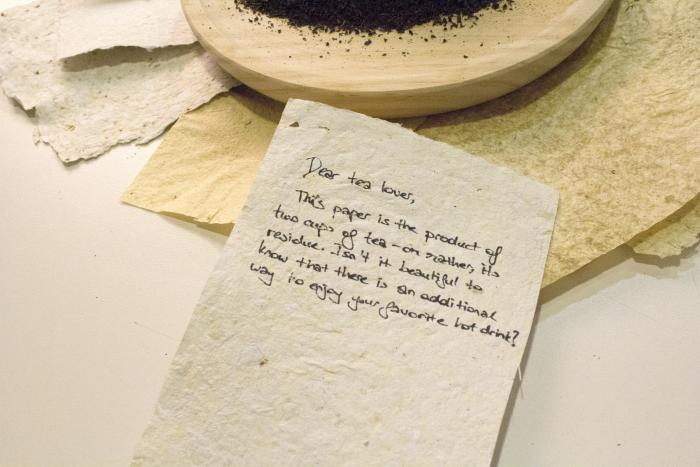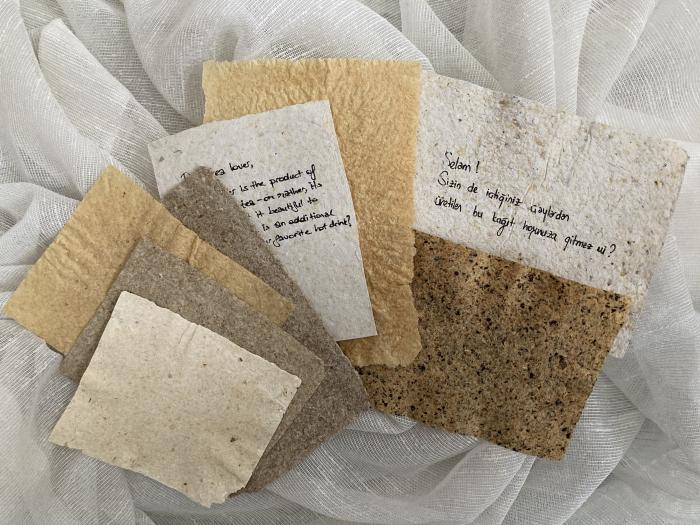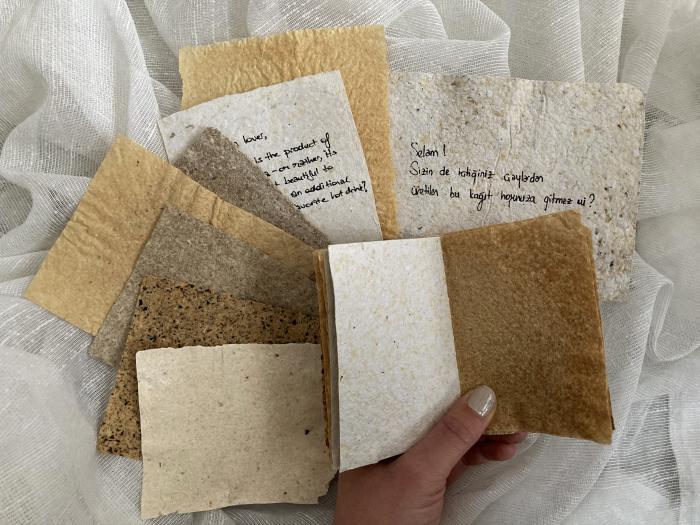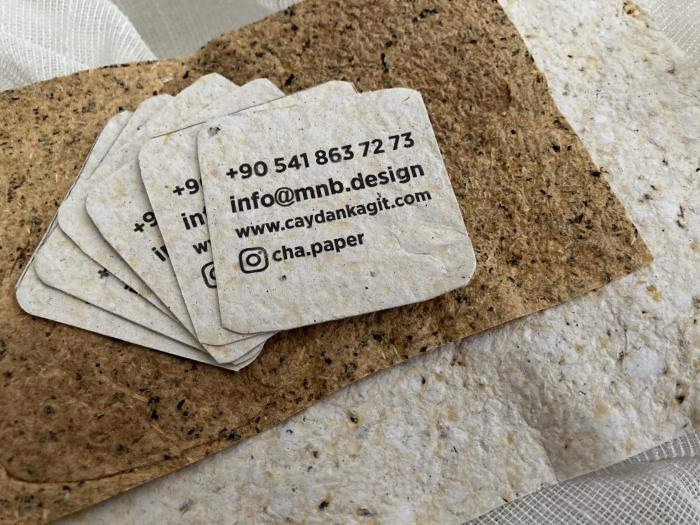I. SUMMARY INFORMATION
Project
267648
Status
Submitted
Award category
Techniques, materials and processes for construction and design
You want to submit
NEW EUROPEAN BAUHAUS RISING STARS : concepts or ideas submitted by young talents (aged 30 or less)
Project title
Cha Paper
Full concept/idea title
Cha Paper is a brand new paper material made of 100% brewed black tea leftovers.
Description
Cha Paper is a paper material made of 100% brewed black tea leftovers, an ingredient that can be found in abundance around the world. It is recyclable. It is authentic due to its different & unseen textures which evolves from its core element, tea leaves. It is sustainable because of turning organic waste to staple good for countries. But also it cuts off almost 40% of the current paper production process; which means less energy and water use.
Where is your concept/idea being developed or intended to be implemented in the EU?
Germany
Berlin
Kreuzberg
Berlin
10961
II. DESCRIPTION OF THE PROJECT
Please provide a summary of your concept/ idea
Cha Paper is a paper material made of 100% brewed black tea leftovers, an ingredient that can be found in abundance around the world. It is recyclable. It is authentic due to its different & unseen textures which evolves from its core element, tea leaves. It is sustainable because of turning organic waste to staple good for country. But also it cuts off almost 40% of the current paper production process; which means less energy and water use.
The creation of Cha Paper revolves around a simple idea: Using a waste material in order to create a sustainable and eco-conscious product with societal impact.
Turning organic waste to staple good is not the only environmental benefit that Cha Paper offers: it also promises to cut half of the current wood-chips-to-paper production process; which means less energy and water use. This reduction is not only possible by the obvious use of organic leftovers as raw material, but also by cutting off the initial creation of the wood pulp. In addition to high levels of energy and water use to create wood pulp, we can compare the 55% yield ratio of wood pulp/dry wood (i.e. 1000 kg of dry wood provides 550 kg of wood pulp) to that of tea leftovers, which is 90%. As paper industry is one of the biggest energy and water wasting industry around the world; Cha Paper offers a sustainable way to over come this obstacle and minimize the dependence on water and energy usage.
By using a cultural symbol to offer an eco-friendly and cost-effective solution to a widely felt ecological problem, Cha Paper can revolutionize paper production approach to recycling, up-cycling and environmentalism.
Please give information about the key objectives of your concept/idea in terms of sustainability and how these would be met
Paper industry is one of the biggest industries around the world and spends extreme levels of energy and water to exist. As we know; creation of one paper bag is much more worst than a plastic bag for the environment. To reduce the energy and water use in the industry; we believe that tea can be our friend and advocate in overcoming this obstacle. The use of tea waste in industrial production has the promise of a significant reduction in environmental impact. This reduction is not only possible by the obvious use of organic leftovers as raw material, but also by cutting off almost 40% of the current paper production process, namely, the initial creation of the wood pulp. In addition to high levels of energy and water use to create wood pulp, we can compare the 55% yield ratio of wood pulp/dry wood (i.e. 1000 kg of dry wood provides 550 kg of wood pulp) to that of tea leftovers, which is 90%.
By Cha Paper project is aimed to support circular economy model to let people benefit from their own residues; simultaneously create more opportunities for self-sufficiency on environmental & social level. Instead of sending this important residue to landfill, empowering the society to collect their leftovers for paper production and rejoining these residues into the circle again.
Tea is very iconic how beverage, it is possible to find a tea shop or cafe in every corner. They are busy cafes all time during the day and they are getting even more popular every day. So as baby steps; starting from these new tea cafes to collect their residues and sell them in their cafes is aimed. So that people can see what could be done within the tea they consume in those cafes & in long term, through a campaign, they can start separating their residues at home. By creating an immediate link between the waste and a material which corresponds to urgent needs, environmental awareness can evolve from its present state to a tangible, beneficial concept in the collective mindset.
Please give information about the key objectives of your concept/idea in terms of aesthetics and quality of experience beyond functionality and how these would be met
Cha Paper has this different & unseen textures which evolves from its core element, tea leaves. Cha Paper could be used as a writing paper, printing paper and as well as in the fantasy paper industry such as in invitation cards.
There are five different types of Cha Paper which are all different from each other and creates different examples around the common paper industry.
The first prototype with half of recycled paper is created as an organic paper pattern, which is by nature rougher than conventional paper. It cuts off 50% of paper usage to create a similar type of function.
The second prototype has a smoother texture than the first prototype. It has a plain surface which allows the user to write properly. It can, therefore, help reduce the use of paper in notebooks and similar stationery.
The third prototype created with 50% processed tea leftovers and 50% unprocessed tea leftovers which was created to show the authentic pattern of the tea leftover combination. Its organic pattern and texture makes this product suitable for aesthetic purposes such as gift wrapping, or as a canvas for arts and crafts.
The fourth prototype comes 100% processed tea leftovers which was the first of the two intended results for the project. It is made completely out of processed tea residue, without any additive elements. It presents a natural color and pattern, highly resembling those of craft paper. Its smooth surface and thin, translucent texture makes it easy to write or draw on it.
The last prototype is for the use of the printing industry, rather than the more natural, craft-paper-like results of the earlier trials. It has a sleek surface as well as an elastic texture; which provides a smooth writing and drawing experience.
All the prototypes have unseen and authentic textures and surfaces to be used in different fields in paper based industries, which evolves from its core element, tea leftovers.
Please give information about the key objectives of your concept/idea in terms of inclusion and how these would be been met
By the project it is aimed to show the people how to easily live circular and how to turn the basic waste into a useful and necessary product. For example; people who goes to the tea houses can reach our products as a menu made of Cha Paper. As well as those people will know the life cycle of the tea they consume. This might make the consumers be more mindful about the life cycle of products and the opportunities we can create out of waste in the collective mind.
We believe that tea can be our friend and advocate in overcoming the obstacle of sustainability idea in such countries like Turkey. By creating an immediate link between the waste and a material which corresponds to urgent needs, recycling can evolve from its present unseen-therefore-nonexisting state to a tangible, beneficial concept in the collective mindset. An example: like in many workplaces in the said country, very large quantities of tea are consumed in the Turkish newspaper offices – a sector that is online 24/7. In this case, Cha Paper offers journalism a chance to sustainability in the simplest possible way – drink tea to publish more.
As the second part of the project; we would like to get into the houses and collect tea residues from house owners directly, by creating a collection system in each neighborhood. So that we can reach as many people as we can to spread the circularity idea and our product.
Please explain the innovative character of your concept/ idea
Life-cycle of Cha Paper starts from the end life-cycle of black tea. This is why it has a system that reduces the normal paper production process by 40% by using the waste material that has been already extracted, without the need for an another raw material procurement. Basically; it cuts off the wood to chips process for paper production. Cha Paper production process has mainly five steps; collecting the tea leftovers, cleaning, non-chlorine bleaching, shaping and drying.
The end result of the process creates the main difference from the similar products. Depending on the percentages of processed and unprocessed tea leftovers that has been used in the process, it is possible to create very authentic and unseen textures on the paper.
Mainly; the production process and the end results of the unseen textured papers creates the difference and the sustainable innovation.
Please detail the plans you have for the further development, promotion and/or implementation of your concept/idea, with a particular attention to the initiatives to be taken before May 2022
In Nielsen Global Corporate Sustainability Report, Nielson found that “73% of global Millennials are willing to pay extra for sustainable offerings.”. This is why we build the marketing strategy depending on millennials. We aim to reach as many German millennials as we can through social media and online adverts. We will use social media channels to reach our audience as known as millennials spent an average of 3 hours each day on social media. We will be reaching them through our Instagram, and YouTube channels, also we are planning to cooperate with some influencers on sustainability area from Germany.
Even the prototyping process has been developed in İstanbul, Turkey, in the country that tops the list of tea consumption; we would like to start with Germany due to generalized idea of sustainability. Right now the main focus is to open up to Europe starting from Berlin, Germany which has a significant tea consumption due to its Turkish population and as well as the excessive numbers of second generation tea shops. In a year; it is aimed to settle down in Kreuzberg, Berlin, open the production studio, and continue the production process there.
First; the production studio will be opened. Then, the main agreements with those tea shops will be set to collect their residues and sell the papers in their cafes is aimed. During these period, we will be also focusing on marketing, through our online channels as well. Then the tea waste collection system will be organized, as we will be visiting the cafes once or twice a week based on how much waste they will produce. Later on; the production will start after obtaining all the necessary equipments and machinery.
First; it is aimed to sell the products in our online shop and the tea cafes and shops. We would like to start with tea cafes / shops because we would like to show the circular lifecycle of the tea to the people to keep it interesting.
III. UPLOAD PICTURES
IV. VALIDATION
By ticking this box, you declare that all the information provided in this form is factually correct, that the proposed concept/idea has not been proposed for the New European Bauhaus Rising Stars Awards more than once in the same category.
Yes



